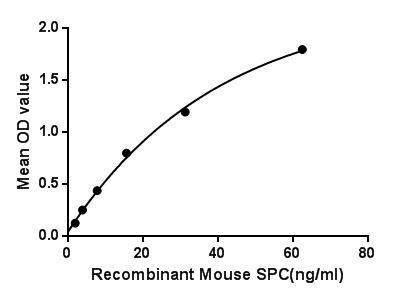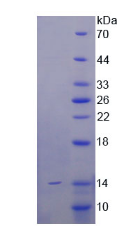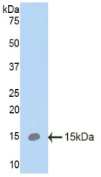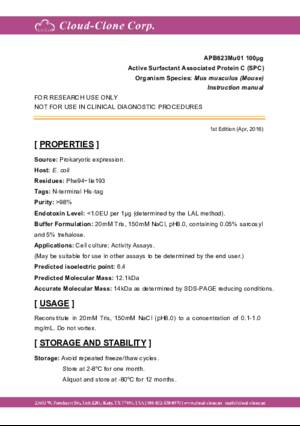Active Surfactant Protein C (SP-C)
SFTPC; PSP-C; SFTP2; SPC; SP5; Surfactant Associated Protein C; Pulmonary Surfactant Protein C; Pulmonary surfactant-associated proteolipid SPL(Val)
- Product No.APB623Mu01
- Organism SpeciesMus musculus (Mouse) Same name, Different species.
- Buffer Formulation20mM Tris, 150mM NaCl, pH8.0, containing 1mM EDTA, 1mM DTT, 0.01% SKL, 5% Trehalose and Proclin300.
- Traits Freeze-dried powder
- Purity> 97%
- Isoelectric Point6.4
- ApplicationsCell culture; Activity Assays.
- DownloadInstruction Manual
- UOM 10µg50µg 200µg 1mg 5mg
- FOB
US$ 324
US$ 810
US$ 1620
US$ 4860
US$ 12150
For more details, please contact local distributors!
ACTIVITY TEST

Figure. The binding activity of SPC with EIF2aK3.
Surfactant associated proteins (SPC), is one of the pulmonary surfactant proteins. It is a membrane protein which manufactures surfactant. The propeptide of pulmonary surfactant C has an N-terminal alpha-helical segment whose suggested function was stabilization of the protein structure, since the latter can irreversibly transform from its native alpha-helical structure to beta-sheet aggregates and form amyloid fibrils. Besides, Eukaryotic Translation Initiation Factor 2 Alpha Kinase 3 (EIF2aK3) has been identified as an interactor of SPC, thus a binding ELISA assay was conducted to detect the interaction of recombinant mouse SPC and recombinant mouse EIF2aK3. Briefly, SPC were diluted serially in PBS with 0.01% BSA (pH 7.4). Duplicate samples of 100uL were then transferred to EIF2aK3-coated microtiter wells and incubated for 2h at 37℃. Wells were washed with PBST and incubated for 1h with anti-SPC pAb, then aspirated and washed 3 times. After incubation with HRP labelled secondary antibody, wells were aspirated and washed 3 times. With the addition of substrate solution, wells were incubated 15-25 minutes at 37℃. Finally, add 50µL stop solution to the wells and read at 450nm immediately. The binding activity of SPC and EIF2aK3 was shown in Figure 1, and this effect was in a dose dependent manner.
USAGE
Reconstitute in 20mM Tris, 150mM NaCl (pH8.0) to a concentration of 0.1-1.0 mg/mL. Do not vortex.
STORAGE
Avoid repeated freeze/thaw cycles. Store at 2-8°C for one month. Aliquot and store at -80°C for 12 months.
STABILITY
The thermal stability is described by the loss rate. The loss rate was determined by accelerated thermal degradation test, that is, incubate the protein at 37°C for 48h, and no obvious degradation and precipitation were observed. The loss rate is less than 5% within the expiration date under appropriate storage condition.
GIVEAWAYS
INCREMENT SERVICES
-
 BCA Protein Quantification Kit
BCA Protein Quantification Kit
-
 Molecular Mass Marker for Protein
Molecular Mass Marker for Protein
-
 Monoclonal Antibody Customized Service
Monoclonal Antibody Customized Service
-
 Polyclonal Antibody Customized Service
Polyclonal Antibody Customized Service
-
 Protein Activity Test Experiment Service
Protein Activity Test Experiment Service
-
 Electrophoretic Mobility Shift Assay (EMSA) Experiment Service
Electrophoretic Mobility Shift Assay (EMSA) Experiment Service
-
 Buffer
Buffer
-
 Lentivirus Packaging Experiment Service
Lentivirus Packaging Experiment Service
-
 Adenovirus Packaging Experiment Service
Adenovirus Packaging Experiment Service
-
 Real Time PCR Experimental Service
Real Time PCR Experimental Service
-
 Spike RBD Protein (S-RBD)
Spike RBD Protein (S-RBD)
-
 Protein G
Protein G
-
 Protein A
Protein A
| Magazine | Citations |
| American Journal of Rhinology & Allergy | Detection of surfactant proteins A, B, C, and D in human nasal mucosa and their regulation in chronic rhinosinusitis with polyps PubMed: 23406594 |
| Plos one | Staphylococcus aureus and Pseudomonas aeruginosa Express and Secrete Human Surfactant Proteins PubMed: PMC3551896 |
| Plos one | The Detection of Surfactant Proteins A, B, C and D in the Human Brain and Their Regulation in Cerebral Infarction, Autoimmune Conditions and Infections of the CNS PubMed: PMC3787032 |
| Nachweis und Charakterisierung des Oberfl?chenproteins PLUNC (Palate, Lung and Nasal Clone Protein) an der Augenoberfl?che und Bedeutung für das Trockene Auge Opus4:Source | |
| Mol Cell Biochem | Autophagy regulates hyperoxia-induced intracellular accumulation of surfactant protein C in alveolar type II cells PubMed: 26122393 |
| Plos One | Serum Levels of Surfactant Proteins in Patients with Combined Pulmonary Fibrosis and Emphysema (CPFE) Pubmed:27337142 |
| PLoS One | The Cerebral Surfactant System and Its Alteration in HydrocephalicConditions. pubmed:27656877 |
| Frontiers in Aging Neuroscience | Correlations of Ventricular Enlargement with Rheologically Active SurfactantProteins in Cerebrospinal Fluid. pubmed:28101052 |
| Frontiers in Aging Neuroscience | Correlations of Ventricular Enlargement with Rheologically Active Surfactant Proteins in Cerebrospinal Fluid PMC5209370 |
| American Journal of Physiology. Lung Cellular and Molecular Physiology | Chronic lung injury and impaired pulmonary function in a mouse model of acid ceramidase deficiency. pubmed:29167126 |
| Respiratory research | Effects and molecular mechanisms of intrauterine infection/inflammation on lung development Pubmed:29747649 |
| Lung | Serum Surfactant Protein Levels in Patients Admitted to the Hospital with Acute COPD Exacerbation Pubmed:29445934 |
| Molecular Neurobiology | Rheologically Essential Surfactant Proteins of the CSF Interacting with Periventricular White Matter Changes in Hydrocephalus Patients–Implications for CSF … Doi: 10.1007/s12035-019-01648-z |
| Stem Cells International | Adipose Tissue-Derived Stem Cells Have the Ability to Differentiate into Alveolar Epithelial Cells and Ameliorate Lung Injury Caused by Elastase-Induced Emphysema … |
| Stem Cells International | Efficient Differentiation of Mouse Induced Pluripotent Stem Cells into Alveolar Epithelium Type II with a BRD4 Inhibitor Pubmed: 31949433 |
| Catalog No. | Related products for research use of Mus musculus (Mouse) Organism species | Applications (RESEARCH USE ONLY!) |
| APB623Mu01 | Active Surfactant Protein C (SP-C) | Cell culture; Activity Assays. |
| RPB623Mu01 | Recombinant Surfactant Protein C (SP-C) | Positive Control; Immunogen; SDS-PAGE; WB. |
| RPB623Mu02 | Recombinant Surfactant Protein C (SP-C) | Positive Control; Immunogen; SDS-PAGE; WB. |
| PAB623Mu01 | Polyclonal Antibody to Surfactant Protein C (SP-C) | WB; IHC; ICC; IP. |
| PAB623Mu02 | Polyclonal Antibody to Surfactant Protein C (SP-C) | WB; IHC; ICC; IP. |
| SEB623Mu | ELISA Kit for Surfactant Protein C (SP-C) | Enzyme-linked immunosorbent assay for Antigen Detection. |
| LMB623Mu | Multiplex Assay Kit for Surfactant Protein C (SP-C) ,etc. by FLIA (Flow Luminescence Immunoassay) | FLIA Kit for Antigen Detection. |









